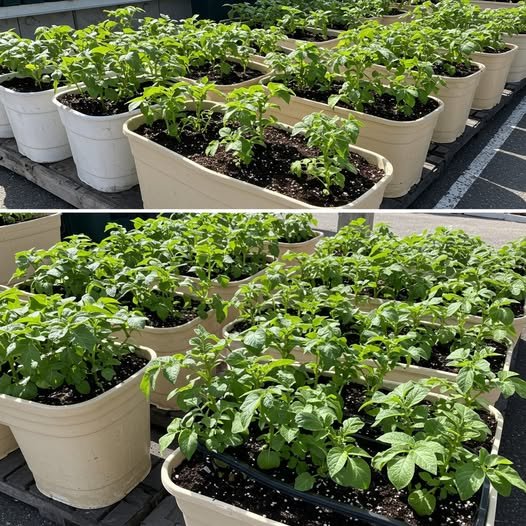The Secret to Growing Potatoes All Year Round
Potatoes are a staple crop in many households, providing a versatile and nutritious food source. However, most people believe that potatoes can only be grown during specific seasons. The truth is, with the right techniques and a little effort, you can grow potatoes all year round, ensuring a constant supply of fresh tubers straight from your garden. Whether you have a large garden, a small backyard, or even limited space for container gardening, this method will help you achieve year-round potato harvests.
Choosing the Right Potato Varieties
To successfully grow potatoes throughout the year, selecting the right varieties is crucial. There are three main types of potatoes based on their growing time:
First early potatoes – These mature quickly, typically in 10-12 weeks, making them ideal for successive planting.
Second early potatoes – These take about 13-17 weeks to mature and can extend your harvesting period.
Maincrop potatoes – These take 18-20 weeks to mature and are suitable for long-term storage.
For year-round growth, consider planting a combination of these varieties at different times to ensure a continuous harvest.
Selecting the Best Growing Method
Growing potatoes throughout the year requires adapting to the changing seasons. Here are the best methods for different conditions:
1. Traditional Ground Planting
If you have ample space, traditional planting in the ground is an excellent option. In warmer regions with mild winters, potatoes can be planted in staggered intervals throughout the year. In colder climates, this method works well from spring to early fall.
2. Raised Beds
Raised beds provide better drainage, improved soil quality, and help protect the potatoes from frost. They are an excellent choice for year-round growing in moderate climates.
3. Container Gardening
For those with limited space or living in colder regions, containers are an ideal solution. Large pots, grow bags, or even repurposed buckets can be used to cultivate potatoes indoors or in protected outdoor spaces.
4. Greenhouses & Cold Frames
A greenhouse or cold frame extends the growing season by providing warmth and protection from frost. This setup allows potatoes to be grown even in winter, ensuring a year-round supply.
Soil Preparation and Fertilization
Potatoes thrive in well-draining, loose, and nutrient-rich soil. Follow these steps for optimal soil preparation:
Use a mix of compost, aged manure, and garden soil to create a fertile growing environment.
Ensure a slightly acidic to neutral pH (5.5-7.0) for best results.
Add organic fertilizers rich in potassium and phosphorus to support tuber development.
Rotate crops to prevent soil depletion and reduce disease risks.
Planting Schedule for Continuous Harvest
To maintain a steady supply of potatoes, follow a staggered planting schedule:
Early Spring (March-April) – Plant first early potatoes.
Late Spring (May-June) – Plant second early potatoes.
Summer (July-August) – Plant maincrop potatoes.
Fall (September-October) – Start greenhouse or container planting for winter growth.
Winter (November-February) – Continue growing in greenhouses, cold frames, or indoors.
By carefully planning your planting cycles, you can achieve a consistent potato harvest throughout the year.
Proper Care and Maintenance
To ensure a healthy potato crop, follow these essential care tips:
Watering: Potatoes need consistent moisture, especially during tuber formation. Water deeply but avoid overwatering to prevent rot.
Hilling: As the plants grow, mound soil around the base to encourage more tuber production and prevent greening.
Pest Control: Monitor for common pests like potato beetles and aphids. Use organic pest control methods such as neem oil or introducing beneficial insects.
Disease Prevention: Avoid overcrowding, ensure good air circulation, and remove any infected plants to prevent diseases like blight.
Harvesting and Storing Potatoes
Potatoes are ready to harvest once the foliage begins to yellow and die back. Here’s how to harvest and store them properly:
First early potatoes: Harvest when they are small and tender, usually 10-12 weeks after planting.
Maincrop potatoes: Leave them in the ground until the skins have thickened for better storage.
Storage tips: Cure harvested potatoes in a cool, dark, and dry place for a week before storing them in a ventilated container to prevent sprouting.
Conclusion
Growing potatoes year-round is achievable with proper planning, variety selection, and the right growing techniques. Whether using traditional ground planting, raised beds, containers, or a greenhouse, you can enjoy a continuous supply of homegrown potatoes. By following these methods, you’ll never run out of fresh, delicious potatoes, no matter the season!



